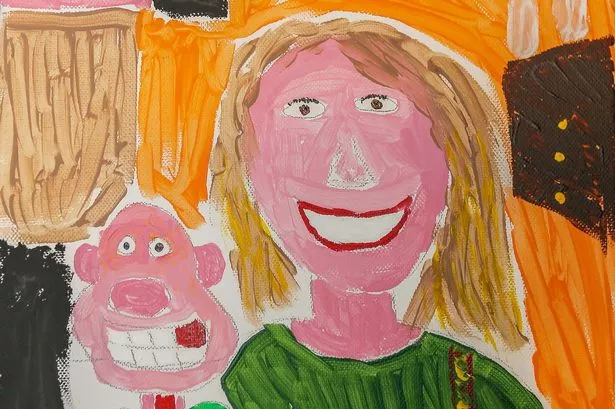The unexpected journey of Jamie Matthias from internet laughingstock to celebrated artist began with a single, hilariously bad portrait. His wife, embracing the humor in his artistic ineptitude, shared the drawing online, expecting perhaps a chuckle from friends and family. Instead, the portrait sparked a wildfire of amusement across the internet, catapulting Matthias into viral stardom. The image, a crude yet endearing depiction of his wife, resonated with a global audience who found its unconventional charm irresistible. This seemingly unremarkable act of sharing a family joke became the unlikely catalyst for Matthias’s burgeoning art career, a testament to the unpredictable power of the internet and its ability to transform everyday moments into extraordinary phenomena.
The initial viral wave was largely driven by the sheer comedic value of the portrait. Its distorted proportions, misplaced features, and overall childlike simplicity struck a chord with a digital audience saturated with polished, professional content. Matthias’s portrait offered a refreshing dose of unpretentious, raw creativity. It resonated with people who appreciated the humor in imperfection and celebrated the authentic, unfiltered expression of artistic intent. Furthermore, the context of the portrait, a loving husband’s attempt to capture his wife’s likeness, added a layer of endearing charm to the piece. It wasn’t just a bad drawing; it was a testament to a playful, affectionate relationship, making the image even more relatable and shareable. The internet, a breeding ground for memes and viral trends, readily embraced the portrait, propelling Matthias into the unexpected spotlight.
However, the story doesn’t end with a fleeting moment of internet fame. The surprising twist in Matthias’ narrative lies in the subsequent recognition he received from the art world. What began as an online joke evolved into a genuine appreciation for his unique style. Art critics and enthusiasts, intrigued by the public’s fascination with Matthias’ work, began to analyze his creations through a different lens. They recognized an inherent, albeit unconventional, artistic merit in his pieces. The raw, untutored approach, initially perceived as humorous ineptitude, became a symbol of artistic liberation, a rejection of traditional standards and a celebration of uninhibited expression.
Matthias’s work, characterized by its simple lines, distorted perspectives, and bold use of color, resonated with certain art movements that valued emotional impact over technical precision. His portraits, despite their anatomical inaccuracies, often captured the essence of the subject, conveying personality and emotion through a minimalist approach. This unexpected depth within his seemingly simplistic style captivated viewers and critics alike, elevating his work beyond the realm of internet humor and into the sphere of legitimate art. The stark contrast between the initial ridicule and the subsequent artistic validation highlighted the subjective nature of art and the transformative power of context.
The story of Jamie Matthias serves as a fascinating case study in the contemporary art world, demonstrating the blurring lines between amateur and professional, humor and high art, and the ever-increasing influence of the internet on artistic recognition. His trajectory, propelled by a single viral image, highlights the democratizing force of the digital landscape, allowing artists outside the traditional gallery system to gain global recognition. It also underscores the evolving definition of art itself, challenging established notions of skill and technique and embracing a broader spectrum of creative expression. Matthias’s work, born from a place of unpretentious enjoyment, evolved into a commentary on the accessibility and inclusivity of art in the digital age.
Ultimately, the Matthias phenomenon became more than just a viral story; it sparked a conversation about the nature of art, the role of the audience, and the power of the internet to shape artistic narratives. His accidental foray into the art world challenged preconceived notions about artistic talent and demonstrated how the convergence of humor, accessibility, and online virality can create unlikely artistic stars. His continued success and the ongoing discussion surrounding his work serve as a testament to the evolving, dynamic nature of art in the 21st century and the surprising ways in which artists can find their voice and their audience in the digital age.














